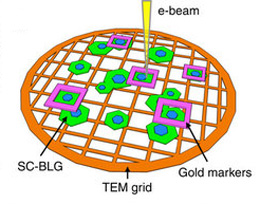Research Abstract
グラフェンのステップエッジから端面内成長のin situSTEM観察
In situ observation of step-edge in-plane growth of graphene in a STEM
2014年6月2日 Nature Communications 5 : 4055 doi: 10.1038/ncomms5055

SiやIII-V族半導体と比べて、グラフェンの成長方向の制御は極めて難しい。今回我々は、走査型透過電子顕微鏡中でのグラフェンの成長とドメインの形成の直接観察について報告する。この際、電子顕微鏡チャンバーに残留した炭化水素を2層グラフェン基板のステップエッジにおけるグラフェンの面内成長の炭素源として利用した。グラフェンの成長方向がステップエッジ構造に強く影響を受け、再構成された5-7員環の終端から成長した領域が母層に対して30°回転していることを示す。さらに、Siのような単一ヘテロ原子が、ステップエッジ成長の触媒活性サイトとなる可能性がある。今回の知見は、望み通りの特性を持つカーボンナノ構造体を作るのに用いることができ、グラフェンの成長と欠陥再構成の機構を解明する手掛かりとなる。
劉崢1, 林永昌1, 呂俊頡2, 葉昭輝2, 邱博文2, 飯島 澄男1 & 末永 和知1
- 産業技術総合研究所 ナノチューブ応用研究センター
- 清華大学 電子工程研究所(台湾)
It is extremely difficult to control the growth orientation of the graphene layer in comparison to Si or III–V semiconductors. Here we report a direct observation of graphene growth and domain boundary formation in a scanning transmission electron microscope, with residual hydrocarbon in the microscope chamber being used as the carbon source for in-plane graphene growth at the step-edge of bilayer graphene substrate. We show that the orientation of the growth is strongly influenced by the step-edge structure and areas grown from a reconstructed 5–7 edge are rotated by 30° with respect to the mother layer. Furthermore, single heteroatoms like Si may act as catalytic active sites for the step-edge growth. The findings provide an insight into the mechanism of graphene growth and defect reconstruction that can be used to tailor carbon nanostructures with desired properties.

